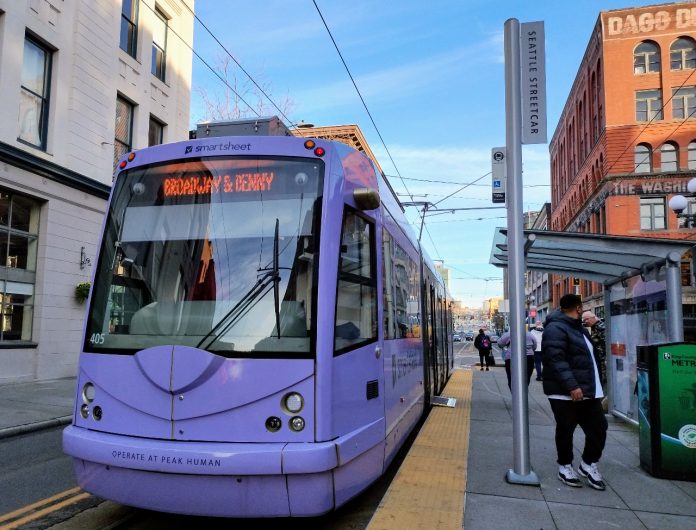
A new consultant report on the long-planned streetcar shows costs up 43% with several new project elements now assumed necessary.
Connecting Seattle’s two existing streetcar lines could cost the City $410 million dollars and take a full seven years, according to a newly released consultant’s report on the long-dormant Center City Connector project, rebranded the Cultural Connector. That new cost estimate represents a 43% increase compared to the previous estimate of $286 million the City produced in 2019. With no funding identified for most of the project’s costs, the new report paints a dire picture for the future of the project, which has been moving forward in fits and starts since 2012.
This delivery assessment for the Cultural Connector, which was delivered to the Seattle Department of Transportation (SDOT) last Halloween, was not available for public consumption until now, even as the Seattle City Council missed a key opportunity to allocate local dollars to keep design moving last fall. Without that local match, $7.3 million in federal dollars allocated via the Puget Sound Regional Council are set to be returned this year. A $75 million small starts grant from the Federal Transit Administration (FTA) remains up-in-the-air while the project remains without a full finance plan.
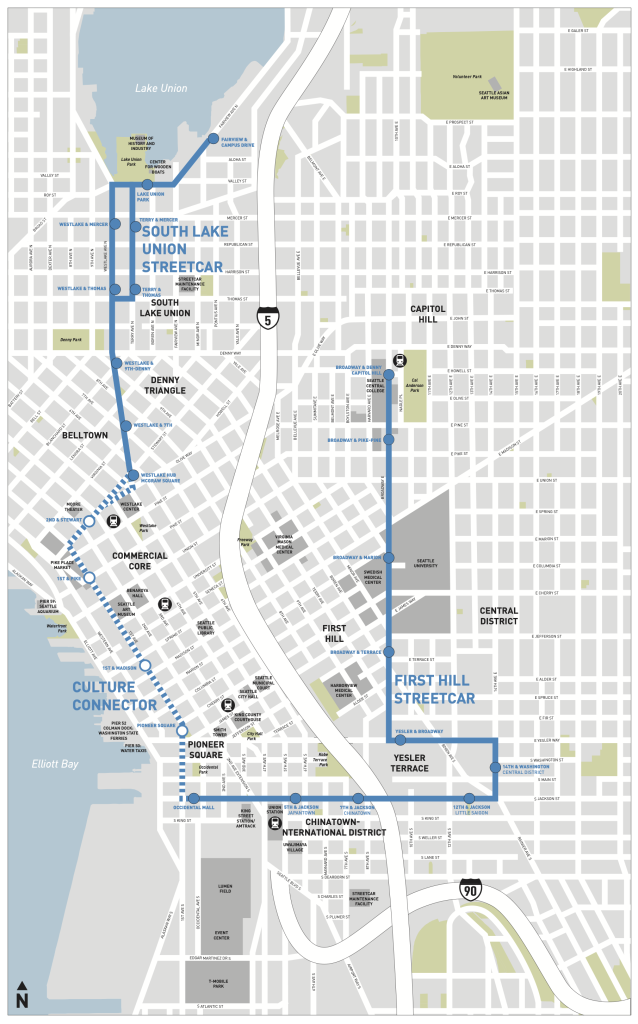
Even though the report is being released now, the Harrell Administration is not proposing any new funding to move the project forward, and it remains on hold. “At this time, there is no change to the status of the project,” an SDOT press released timed with this announcement noted. “The City will continue to engage stakeholders on the Delivery Assessment results and explore opportunities to support Mayor Bruce Harrell’s vision for a linear arts, culture, and entertainment district, of which the Culture Connector is one key element.”
Along with overall inflation, the new cost estimates reflect trends within the transportation industry leading to increased costs, costs that are impacting projects around the entire state. “Since the pause of the 2018 project, there has been general price inflation in the economy, including a period of rapid price escalation, and construction price escalation within the region,” the assessment notes.
These brand new cost estimates include a number of project elements that were not included in the 2019 cost estimates at all, including structural upgrades to underground passageways under city streets in Pioneer Square (called areaways) and upgrades to S Jackson Street, which exists as a bridge over the BNSF railroad tracks near King Street Station. Taken on its own, costs for the streetcar itself are up 22%, or $45 million since 2019, including additional design costs that ultimately replicate past work that’s now out-of-date.
Many of the newly-refreshed cost estimates throughout the project stem from a more thorough analysis of the type of streetcar vehicles that would need to be purchased for the Cultural Connector, after the consultant’s report assumes that the City will not be able to procure similar streetcars to the ones operating on the two existing lines. “From the rail car manufacturing industry perspective, a ten-car order is a small order that will not motivate a manufacturer to develop a completely custom car at a reasonable price,” the report notes, instead assuming that the vehicles that will be purchased will be both heavier and have higher axle loads.
But buried in the report are some significant ways that the City could move forward with the Cultural Connector at a lower total cost, either by separating out some of these significant side costs into separate projects with different timelines, or by rethinking some of the core design assumptions for the project.
According to the delivery assessment, $51.6 million would need to be spent to upgrade Pioneer Square’s areaways, including close to $7 million in design costs, underneath 1st Avenue S and S Jackson Street. “The 2018 Project design had assumed that structural retrofit of the areaways was a long-term issue for the City to address over time and independently of the Project, but SDOT began revisiting this assumption in 2018,” Parsons states.

Another $38.4 million is expected to be required to upgrade a set of bridges that make up two sections of S Jackson Street on either sides of 4th Avenue S, but that figure is ultimately a placeholder with exact costs unknown. SDOT is conducting a parallel assessment of the future of these bridges, that has come up in the discussions of a potential second Chinatown-International District light rail station as a part of Ballard Link. Upgrades to Jackson Street were already made in 2013 and 2014 with installation of the First Hill Streetcar, but those upgrades were only enough to ready the street to handle the current types of streetcar vehicles.
“Although the new streetcar vehicles for the Project have yet to be procured, the expectation is that the structural loads associated with the new, heavier vehicles will require further strengthening or upgrades to the structures,” the report states, noting that while the City could decide to upgrade the bridge decking to handle the new streetcar vehicles, that’s unlikely when the entirety of the two bridges needs to be replaced. “Given that SDOT has initiated a broader study of the bridge rehabilitation and replacement options, deck replacement is not likely to proceed independently of a broader term solution for these bridges.”

Costs related to the project for utility relocation, attributed to Seattle City Light and Seattle Public Utilities, are essentially unchanged since 2019 at approximately $75 million dollars.
Seven year timeline with four years of construction
According to the new delivery assessment, the soonest that Seattle would be able to fully complete the two streetcar lines would be 2031. An additional three years of design work, on top of the work that’s already been completed over the past years, is included in that timeline, though early utility work, including the areaway upgrades, could start before the streetcar project itself reaches 100% design.
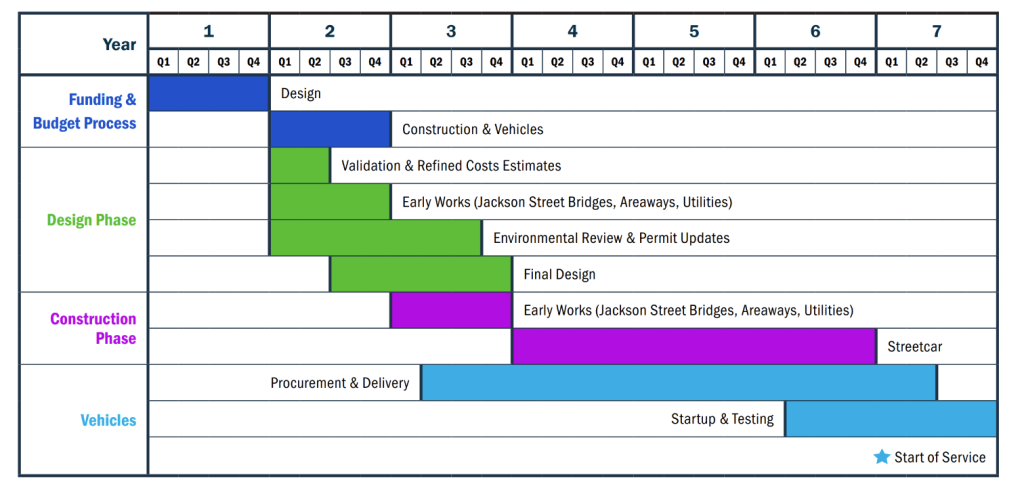
One of the most lengthy elements of the project is new streetcar vehicle procurement, which is expected to take four-and-a-half years, with the $86.5 million expected to be spent on those new vehicles, 37% of the total cost of the streetcar project itself. Eleven new streetcar vehicles would be needed for the full system to comply with the FTA’s requirements for spare vehicle ratios.
Because the project’s timeline is now assumed to run up against construction of a planned South Lake Union light rail station, which could disrupt the existing streetcar on Westlake Avenue, the report lays out a number of mitigation strategies to keep the system somewhat intact, primarily the installation of a new set of streetcar tracks on Lenora Street and Terry Avenue — approximately 2,000 feet of new track that could connect the South Lake Union maintenance facility with the rest of the system while Westlake Avenue was closed. This would cost the City about $16 million to include in the project.

Significant maintenance facility work required to accommodate new streetcars
How to expand the existing maintenance facilities in South Lake Union and Chinatown-International District to accommodate additional streetcar vehicles, especially larger, heavier ones was a hurdle the City grappled with in 2018 when the Center City Connector was put on hold for the first time. But the new report lays out some new obstacles that didn’t exist then, obstacles that are also set to add new costs if the City moves forward.
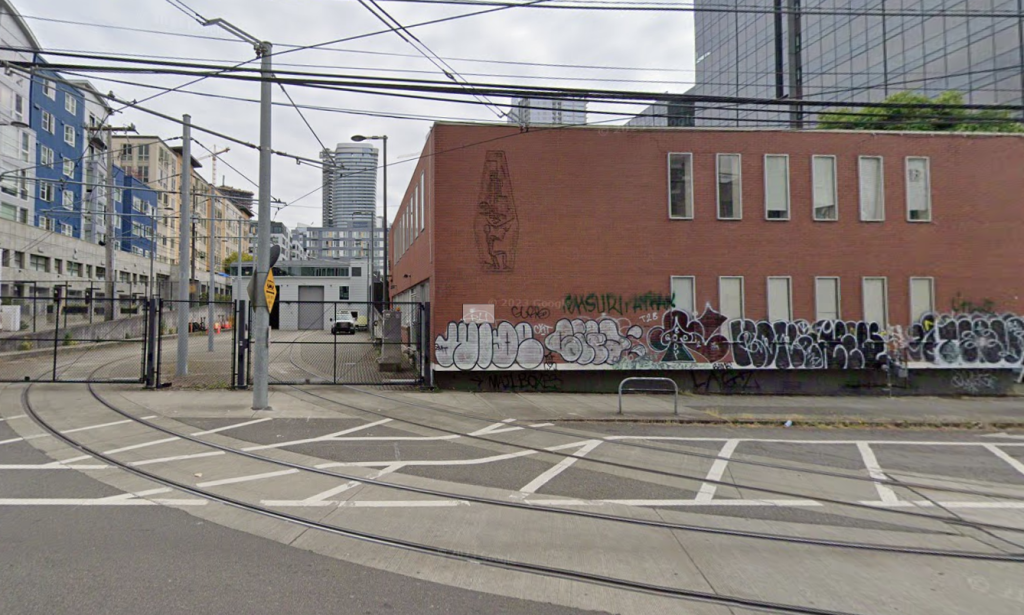
The Bricklayer’s Building, which dates to 1959 and sits directly next to the current South Lake Union streetcar maintenance yard, was designated a city landmark in 2018 after a historic assessment was conducted to determine the feasibility of expanding the streetcar yard. While it’s feasible that the structure could still be demolished, the delivery assessment assumes a low probability of that happening, and instead looks at ways that the building could be accommodated on the site. The building could be retained as an annex building, replacing a small annex built in 2017, or even completely moved to accommodate streetcar vehicle storage.
For cost assumption purposes, though, the delivery assessment assumes that just the facade of the Bricklayer’s Building will be retained, in a similar fashion to the nearby Troy Laundry building on Fairview Avenue N. Ultimately, this just adds another significant cost variable to the once-stable assumptions around expanding the maintenance facility.

Expanding the First Hill maintenance facility is also possible, and could become necessary due to Sound Transit 3 construction in South Lake Union. Storing six additional vehicles at the site would cost approximately $4.3 million dollars, or the City could decide to store the cars outside for a temporary period, leading to $2 to $3 million in security costs to protect the cars from vandalism.
Jackson Street upgrades could be phased in later
The Parsons report, identifying the fact that S Jackson Street would need significant upgrades to be able to carry the type of streetcars that the City would need to purchase to complete the Cultural Connector, identifies an alternative path forward: only operating the new streetcars between South Lake Union and Occidental Mall until Jackson Street was upgraded.
“The new streetcars would operate from South Lake Union through the center city to the same passenger platform in Pioneer Square, where passengers could transfer between the lines. Many trips — such as from Lake Union Park to Pike Place Market — would be served without a transfer, while others would require a transfer in this interim configuration,” the assessment notes. Riders heading up to Capitol Hill would have to transfer in Pioneer Square.
That would remove a direct connection between Westlake, Pike Place, or First Avenue and Chinatown, though a plan to operate two overlaid levels of service as a full Seattle Streetcar network has long been the City’s operating assumptions, with some trips only operating between South Lake Union and Chinatown and others operating on most of the network but turning back before the northern South Lake Union terminus on Fairview Avenue N.
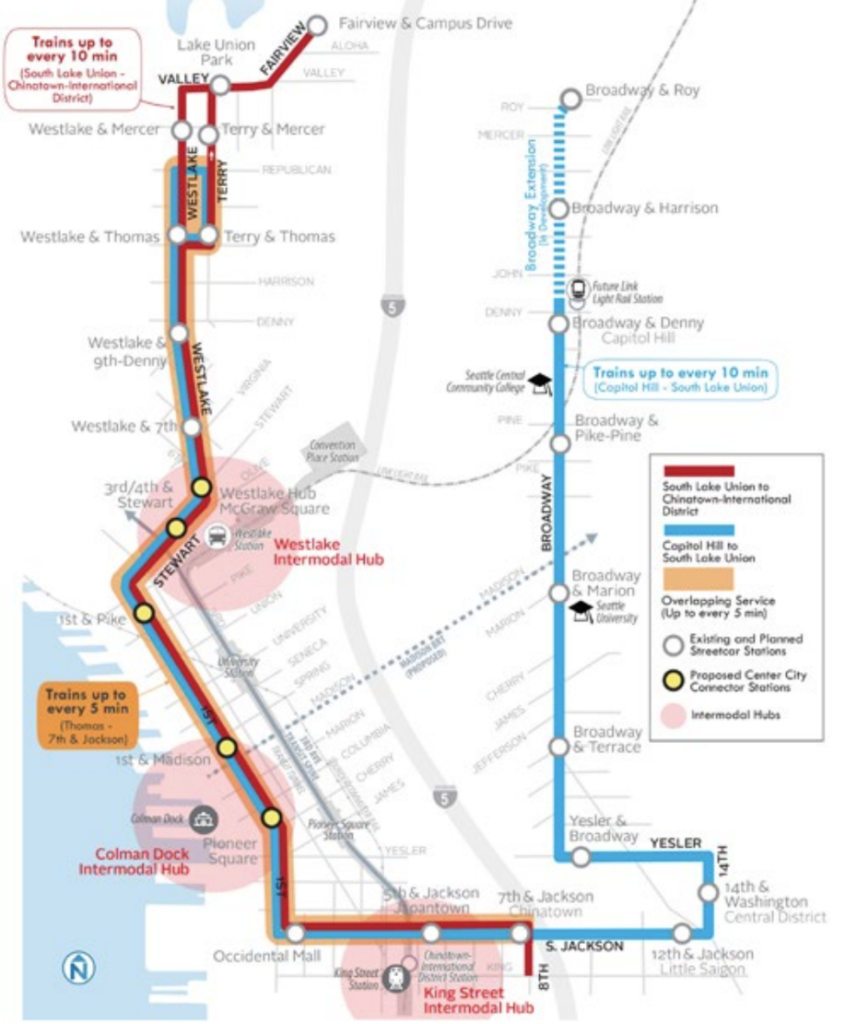
Moving forward with an independent line that avoids Chinatown could shave $38.4 million off the total cost, but, again, those dollars are simply placeholders, with the potential for costs for the replacement or refurbishment of the twin Jackson Street bridges to end up being much more than that.
Pedestrianizing streets in Pioneer Square could reduce project costs
The $51.6 million to upgrade areaways in Pioneer Square could be reduced with a bold urban design proposal outlined in the streetcar’s delivery assessment. Because the curbside lanes are the ones requiring reinforcement to carry heavy streetcars and other vehicles, if First Avenue were to be pedestrianized, with streetcar lanes — that could potentially also carry bus traffic — in the middle of the street, the areaways wouldn’t need to see as much investment.
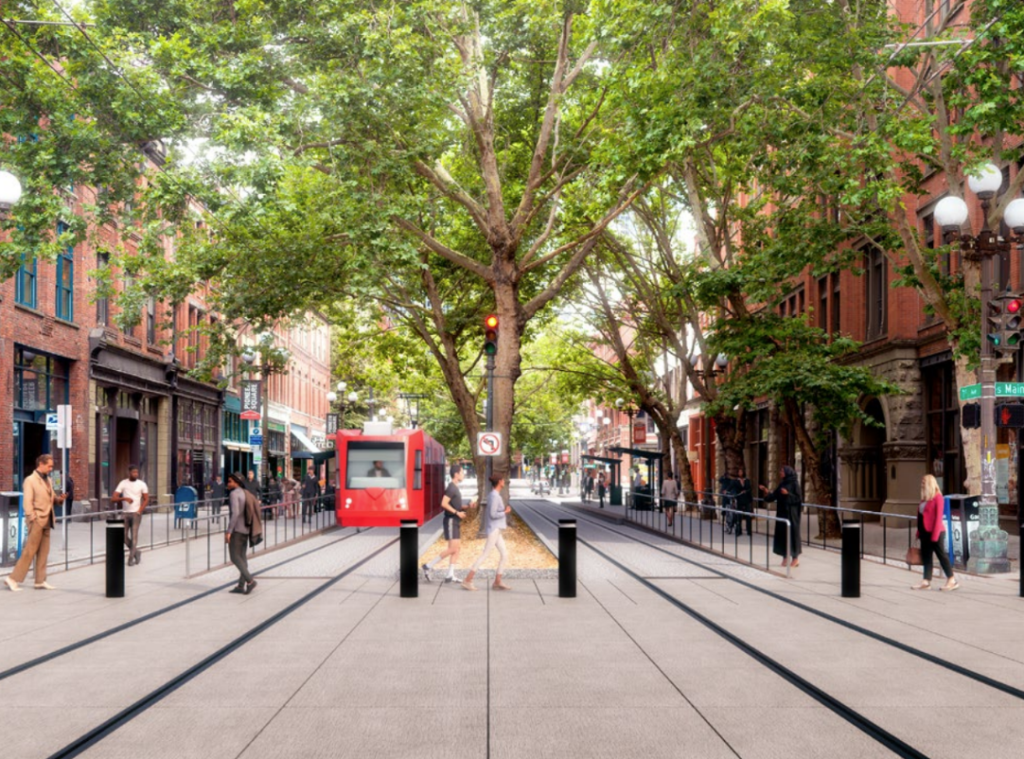
Pedestrianizing one block, between Washington and Main Street, could save the project $5 million dollars, and extending that pedestrianization all the way from Yesler Way to Jackson Street could save up to $17.1 million.
The delivery assessment spends a bit of time analyzing the potential impacts to traffic from these changes, noting that 40% of traffic on First Avenue is expected to move over to the newly built Alaskan Way along the waterfront. Some intersections, particularly along Yesler Way, are expected to see significant delays, but it’s possible those delays never materialize as traffic patterns stabilize.
Significant gains in ridership still expected from a full network
The primary reason to build the First Avenue streetcar was the projected increases in ridership that would be seen on both the new route, and the existing segments of the streetcar network. This week’s report reconfirms those assumptions, with an independent ridership reassessment completed by Parametrix showing that the City should expect over 6,000 daily trips on just the new segment of the line on the day it opens, with over 11,000 per day on the entire streetcar system. By 2045, ridership on the streetcar network is expected to increase by 140% as other elements of the city’s transit network, including new Link stations, are completed, compared to an average 27% increase expected on Seattle’s RapidRide bus lines.
“By 2045, the Culture Connector project forecasts strong potential for overall growth along the streetcar system, particularly at the First Ave & Madison stop and at the Mercer stops along Westlake and Terry Avenues,” the ridership report states. The report also projects a sizable increase in ridership could come from event day service in Pioneer Square, indicating the City could see a 5% to 15% increase in ridership, depending on the type of sporting or concert event taking place.
Keeping in limbo the idea of tying the existing streetcar lines into a unified system raises questions about the future of the Seattle Streetcar as it currently exists. Ridership on the First Hill line between Pioneer Square and Capitol Hill remains robust — something that cannot be said about the South Lake Union line. Initial 2023 ridership numbers through the end of November showed the South Lake Union line on track to significantly miss its ridership projections for the year, forecasts that were already significantly below pre-pandemic ridership levels.
For a high-capacity streetcar that can carry 140 passengers, median daily ridership on the South Lake Union line was set to come in at just over 500 passengers per day last year, with nearby bus routes serving the neighborhood seeing many more daily riders. By 2028, the City of Seattle expects to spend $4.2 million per year in ongoing commercial parking tax funding running just the South Lake Union line. The First Hill line, by contrast, costs about twice as much annually to operate, but sees approximately seven times the number of riders.

All told, the delivery assessment released this week illustrates the enormous hurdles that would need to be surmounted to move the Cultural Connector forward, but also significant opportunities and benefits. With a new Seattle City Council not treating transportation as a priority and facing a significant general fund revenue shortfall in 2025, the future for the streetcar project looks bleak, but it could move forward if the Harrell Administration stepped up and had the vision to make it happen.
Ryan Packer has been writing for The Urbanist since 2015, and currently reports full-time as Contributing Editor. Their beats are transportation, land use, public space, traffic safety, and obscure community meetings. Packer has also reported for other regional outlets including BikePortland, Seattle Met, and PubliCola. They live in the Capitol Hill neighborhood of Seattle.

